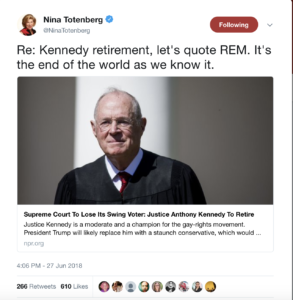Sentimental
I am already getting sentimental about my classes this year. Not to be overly dramatic (I have been spending a lot of time with an adolescent daughter), but many of the cases I teach in LA346: Business, Justice and Responsibility, may soon be obsolete. One of the joys of teaching is returning to the same material every semester, looking at it through 25 new pairs of eyes. It is a great feeling to dig in on something you know, inside and out. Yet every time I teach Roe v. Wade I learn something new about the case, class goes differently, our discussions vary. The richness and depth of the subject matter was something I took for granted, until now. As Nina Totenberg tweeted: “It is the end of the world as we know it…” (Please tell me you know this R.E.M. song).
I was preparing my annual review of three cases this term, Masterpiece Cakeshop v. Colorado Civil Rights Commission, NIFLA v. Becerra, and Trump v. Hawaii, when the news of Justice Kennedy’s retirement broke. Kennedy’s retirement trumps all that happened this term, but I will still summarize my thoughts on these important cases below. Finally, I will add some thoughts on the impact of Kennedy’s retirement.
Masterpiece Cakeshop v. Colorado Civil Rights Commission: Watch your mouth!
The award for most unsatisfying decision goes to Masterpiece Cakeshop. Masterpiece Cakeshop is a bakery owned by Tom Phillips, a man whose religion holds same-sex marriage to be a sin. When a gay couple went into the bakery to order a wedding cake, Phillips refused. He was willing to sell other types of baked goods to LGBTQ customers, just not wedding cakes. The bakery is located in Colorado, a state with a public accommodations law that protects against sexual orientation discrimination, the Colorado Ant-Discrimination Act (CADA). The couple filed a charge with the Colorado Civil Rights Commission, who found the bakery to be in violation of CADA. The case eventually found its way to the Supreme Court, where it was set up to be a battle between religious freedom and gay rights. It was argued as a Freedom of Speech case and decided as a Due Process case. Blah. The Bakery won, with the Court finding that the Commission was not neutral in its application of CADA.
Phillips argued that his wedding cakes were speech. Being forced to make a wedding cake for a gay couple would be compelled speech and a violation of the First Amendment. Cue endless amusing discussion in briefs and oral argument about whether wedding hair is speech, can you eat speech, and on and on. This is the stuff that law school moot court is made of – endless opportunity for comparing and contrasting facts, a subject about which most of us are knowledgeable: cake! Alas, the Court’s majority opinion, written by Kennedy, completely skips speech. Not only does this leave a compelling question unanswered (is cake speech? It does occasionally speak to me.), but it allowed the Court to bypass the conflict between free speech and anti-discrimination laws.
Instead, the Court relied on a line of cases starting with Unemployment Division v. Smith, which held that a generally applicable law (a law that is not designed to target a particular religion but applies to everyone – like an anti-discrimination law) must be applied neutrally. In other words, you a statute cannot target a specific religion. The Masterpiece Cakeshop Court found that the Commission enforcing the anti-discrimination law was not neutral for two reasons: 1) they enforced the law against Phillips when they did not enforce it against three bakers who refused to make cakes that said hateful things about gays; and 2) two of the Commissioners made comments about Phillips, comparing his refusal to Nazi’s using religion to justify the Holocaust, and other bad actors. Essentially the Court drew a procedural due process conclusion- if you are going to enforce CADA, you need to do so fairly.
The reaction in the media to this case, thanks in part to Justice Kennedy’s kind words about the rights and dignity of gay persons, was “don’t worry.” The opinion emphasizes throughout, as did the media, that it is very, very narrow. In theory, the decision should not eliminate the ability to enforce anti-discrimination laws in the face of religious objections. If the anti-discrimination laws are enforced fairly and the enforcing body keeps its comments to itself, the case turns out differently. At least that is the “this is so narrow” argument.
This case is not as narrow as Kennedy claims. The other cases where the Colorado Commission allowed bakers to refuse to bake cakes are different from Phillips’ situation in important ways. As Justice Ginsburg’s dissent stated better than I can, those bakers would have refused to bake those hateful cakes for any customer, regardless of their religion. The bakeries were not preferring or discriminating against the customers based on their religion. In contrast, Phillips refused to make the same cake he would make for any other customer, based solely on the couple’s sexual orientation. Also, what if those cases had not happened before the Masterpiece case? Those decisions by the Commission were essential to the Court’s ruling that the decision against Masterpiece was an unfair application of the law. What if right after the Commission ruled in a third case the same way it did for Phillips? Is it neutral then? It doesn’t make sense.
The second reason for the lack of neutrality was the comments of two Commissioners about Phillips. While admittedly inflammatory and unnecessary comments, I do not see them as evidence of a lack of due process. There are many layers of hearings and appeals in this process. The comments of two Commissioners should not be able to override a violation of an anti-discrimination law. This holding makes the test whether the Commissioners are smart enough to keep their mouths shut. It creates all sorts of strange incentives that are antithetical to a fair hearing and transparency. Further, if you look carefully at what the Commissioners said, the comments were not hostile to Phillips’s exercise of his religion. They were hostile to his use of religion to discriminate on the basis of sexual orientation. That seems to be squarely in the Commissioners’ job description. Finally, as Justice Sotomayer points out in her scathing dissent in Trump v. Hawaii a couple weeks later, the Court feels free to use these comments as evidence of discriminatory intent, while being unwilling to grant any credence to President Trump’s endless discriminatory tweets about Muslims and immigrants. More on that later.
Masterpiece Cakeshop is disappointing because the Court did not address any of the real questions about what is speech, and how to resolve the conflict between anti-discrimination laws and religion. This is a legitimate conflict between two closely held values of this country – one about which I taught an entire class — and we need guidance. Justice Thomas was the only one to answer the questions in the case. I do not agree with most of what he said – wedding cakes are not the baker’s message, in my mind. The message belongs to the couple, at best. But at least he addressed the hard issues.
I suspect that the liberal Justices had to leave out the real issues in the case because if the Court addressed them, they would have lost. So maybe Kagan and Breyer were saving us from a 5-4 ruling written by Gorsuch (known for his religious freedom jurisprudence, author of the lower court decision in Hobby Lobby that was essentially copied by the Supremes) that ruled that religious freedom trumps the anti-discrimination law.
Justice Kennedy cares deeply about his legacy and has essentially authored all of the big LGBTQ rights cases. His language in Obergefell about love, marriage, and dignity, still brings tears to my eyes every semester, despite laughing to myself about Scalia calling it “fortune cookie language.”
Footnote 22 of Scalia’s Dissent in Obergefell:
If, even as the price to be paid for a fifth vote, I ever joined an opinion for the Court that began: “The Constitution promises liberty to all within its reach, a liberty that includes certain specific rights that allow persons, within a lawful realm, to define and express their identity,” I would hide my head in a bag. The Supreme Court of the United States has descended from the disciplined legal reasoning of John Marshall and Joseph Story to the mystical aphorisms of the fortune cookie.
Thus, Masterpiece Cakeshop hurts more when considered in light of Kennedy’s retirement. It was an opportunity to celebrate the rights of all people to be free from discrimination in their daily lives, as the Court tried to do for African-Americans in cases about lunch counters and BBQ joints. In my mind, what Masterpiece Cakeshop should be remembered for is the missed opportunity by Justice Kennedy to cement his legacy.
NIFLA v. Bercerra: Totally detached from reality
Although Justice Sotomayor often agrees with Justice Ginsburg, they do depart on an important philosophy of judging. Justice Ginsburg has always stated that her gender makes no difference to judging. Justice Sotomayor, while still a Circuit Court Judge, made a speech questioning the famous notion that a wise old woman and a wise old man would reach the same conclusion when deciding cases. She famously said, “I would hope that a wise Latina woman with the richness of her experiences would more often than not reach a better conclusion than a white male who hasn’t lived that life.” Savage, Charles, A Judge’s View of Judging is on the Record, NY Times, May 15, 2009, https://www.nytimes.com/2009/05/15/us/15judge.html
Not surprisingly, this quote got a lot of play during Sotomayor’s confirmation hearings. I couldn’t stop thinking about her quote, and the need for Justices rooted in real life when I read the decision in NIFLA v. Becerra. NIFLA is the National Institute of Family and Life Advocates, an organization that runs crisis pregnancy centers in California. The California Reproductive Freedom, Accountability, Comprehensive Care and Transparency Act (FACT Act) requires that clinics that primarily serve pregnant women must post and hand out certain notices. Specifically, the crisis pregnancy centers must notify women that California provides free or low-cost services, including abortions. (There is a second notice requirement at issue i the case, but I am omitting it for this discussion.) The clinics, who are pro-life and work to reduce abortions, sued, arguing that the FACT Act violates their First Amendment protection against compelled speech.
The clinics won. The Court ruled in a 5-4 decision that they were likely to prevail on their First Amendment claim because the notices are content-based speech – in other words, the government is compelling the clinics to provide a specific message. No exceptions to the strict prohibition against content-based regulation of speech applied.
The majority decision will be quite boring to anyone but a First Amendment scholar. Justice Thomas concludes the Court must apply strict scrutiny to the FACT Act because “by compelling individuals to speak a particular message, such notices alter the content of their speech.” Slip opinion p. 9, internal citations omitted. The lower court and the dissenting Justices disagree. They would rule that a lower level of scrutiny is applied because this is regulation of professional conduct, something that the Court has allowed in many cases. Think about how many notices that businesses are compelled by the law to post or provide to customers. The dissent points out that this notice is no different and should be allowed as long as California has a legitimate interest.
For me, this case shows how Justice Thomas is completely divorced from the reality of a woman entering a crisis pregnancy center. He reasons that posting a notice about the availability of free reproductive health care, including abortion, is not about a medical procedure at all. He thus distinguishes Planned Parenthood v. Casey, where the Court upheld an informed consent requirement for abortion against a First Amendment challenge. Justice Thomas also argues that the law is under-inclusive because it only applies to a subset of clinics and not effective because there are many ways to provide information about free services to women.
I hate to disagree with my hero, RBG, but this is where we need a woman on that bench. Or a man who has occasionally discussed reproductive health with a friend, family member, or loved one. Crisis pregnancy centers play an important role in reproductive health when run responsibly, just as abortion clinics do. Women who go to crisis pregnancy centers are in crisis. They are not reading signs on the subway or other advertising campaigns that Justice Thomas suggests. They are trying to figure out who to trust. They rely on the information provided by the medical professionals in these clinics. If they are not told that they can obtain a free abortion by the state of California, that most certainly could alter their decision on whether to get one. Because they do not have the money to pay for that abortion. Also, the decision to have a baby is inescapably a medical procedure with risks. As Justice Breyer cites in his dissenting opinion, “childbirth is 14 times more likely than abortion to result in the woman’s death.” Slip Opinion, Breyer Dissent at p.13. In particular, the health risks for African-American women having babies are staggering. The United States’ rate of maternal mortality is worse now than 25 years ago. A recent NY Times article on the health dangers to Black women and babies stated, “Black women are three to four times as likely to die from pregnancy-related causes as their white counterparts.” Villarosa, Linda, Why American’s Black Mothers and Babies Are in a Life-or-Death Crisis, NY Times Magazine, April 11, 2018, https://www.nytimes.com/2018/04/11/magazine/black-mothers-babies-death-maternal-mortality.html. California must have the right to require that clinics tell patients that they have medical alternatives to this risky choice, as they are required to disclose in many other medical choices.
Justice Breyer’s dissent points out the most troubling issue for me: “What is sauce for the goose is normally sauce for the gander.” Slip Opinion, Breyer Dissent at p. 12. Many states require that women seeking an abortion receive extensive information about the health risks of abortion, the probable gestational age of the fetus (often with a compelled look at the ultrasound for the mother), a description of the fetus, the availability of adoption, and more. These notifications have been upheld repeatedly by the Court, as part of the state’s interests in protecting the unborn child and maternal health. More specifically, as mentioned above, the case Planned Parenthood v. Casey squarely addressed informed consent for abortion. The Court in Casey stated that “although the physician’s First Amendment rights not to speak were implicated by the Pennsylvania law, it was only as part of the practice of medicine, subject to reasonable licensing and regulation by the State.” Casey, 505 U.S. at 884, internal citations omitted.
Thus, the Court in NIFLA is applying the law unfairly. I am not asking the Court to “adjudicate who is right and who is wrong in this moral debate.” Slip Opinion, Breyer Dissent at p.17-18. What I want the Court to do, however, is to apply the law fairly. If Pennsylvania can require that a clinic disclose the availability of adoption to a patient, California should be able to require that a clinic disclose the availability of abortion.
Of course, the Court has been inconsistent for a long time, it is just that it is now a different set of justices/interests/values are being put in the dissenters’ position. For example, in Lawrence v. Texas, the Court decided that a statute making sodomy a crime for homosexuals was unconstitutional – not as an equal protection violation (which would have been the easy way to strike down the awful law), but as a due process violation. Kennedy’s opinion stated that moral objections are an insufficient government interest to justify violating a person’s right to private, consensual sexual activity in their own home. Scalia’s scathing dissent pointed out the long list of laws that are based on morality – polygamy, bestiality, incest, etc. Scalia is absolutely right, although I think the Texas statute is stupid and mean. The Court’s majority chooses what to prioritize, and we are likely to be entering a time where the Court’s choices conflict with mine. But I have been warning my students to think critically about the Court’s decisions all along because once the tables turn, it will be hard. And here we are.
Trump v. Hawaii– Pay No Attention to the Tweeting Behind that Curtain
I will not get too much in the weeds on this case, as I know nothing about immigration law. Apparently, I do not need to bother to learn anything more, because the answer is always the President can do what he wants. This was the long-awaited case about President Trump’s ban on immigration by citizens of eight nations. The Executive Order was referred to as a “Muslim Ban” because the eight nations chosen are predominantly Muslim. President Trump’s Executive Order explained that the countries had been selected because of terrorism threats. This was the third in a series of similar Executive Orders, and it made its way to the Supreme Court after Hawaii’s District Court entered a preliminary injunction barring enforcement of the entry suspension. The Supreme Court granted cert and allowed the entry suspension to go into effect pending the disposition of the case. Never a good sign for those who wanted to overturn the Executive Order.
The Court concluded that immigration laws provide the President with nearly complete discretion in deciding who gets into this country. That discretion is not controversial, nor has it ever been before. But “before” ended when Trump was elected President, and now all these innocuous elements of our legal system no longer seem that innocuous. Again, that is on us for being unfair: if we like the President we want him to have discretion. If we don’t, we are outraged. I find the anti-Muslim sentiment disgusting, but the legal question is about executive power.
The most troubling aspect of this decision, for me, is articulated in Justice Sotomayor’s dissent. This very same Court had decided just a few days before that the Colorado Commissioners’ comments indicated bias and prejudice against Phillips’ religion so that his right to the neutral application of the anti-discrimination law was violated. And yet, they chose to ignore the many anti-Muslim comments and tweets by President Trump. Rather than acknowledge that those tweets might be evidence of an anti-Muslim bias, and the real reason for the ban on immigration from the selected countries, the Court ignored them. The Court essentially said that we will believe the official story provided in the Executive Order, no matter how much evidence to the contrary. Justice Sotomayor painstakingly describes all of the comments in the press, statements on official websites, and tweets, that provide strong evidence of an Anti-Muslim animus. She calls the Proclamation’s references to national security concerns “window dressing” trying to conceal the fact that the President’s immigration ban is motivated by anti-Muslim bias. Again, what is good for the goose should be good for the gander. If the baker is entitled to a process free of anti-religion commentary, those trying to immigrate should be too.
The Future of the Court
Justice Kennedy’s retirement is a really big deal. The ability of any President to appoint a second Justice is significant; and with RBG hanging on at 85 (keep planking RBG!!), it could be three justices before Trump’s presidency is over. Replacing Scalia with Gorsuch was a wash – one textualist for another. Gorsuch has not been on the Court long enough to make a meaningful impact, and I doubt his decisions will ever be as well written as Scalia’s were. (Scalia is the best legal writer of all time, in my humble opinion.) But the ability to replace the center of the Court is the ability to push the Court squarely into a conservative majority.
President Trump has promised to appoint a Justice who wants to overturn Roe v. Wade. I care deeply about reproductive rights, so much so that I vote for President based solely on this issue. As did the religious right, who held their noses in November 2016 while they voted for a thrice-married, not so holy, reality TV star. The religious right cannot like Donald Trump, but they were smart enough to vote for him anyway, for one reason: the Supreme Court. Liberals were short-sighted and didn’t get out of bed that morning, couldn’t get excited about Hillary Clinton, and lost the chance to secure a lifetime of liberal values on the Supreme Court. Vote.
The Court cannot just wake up in October and decide to overturn Roe. They need a case to do so. There are probably dozens of abortion cases percolating through the lower courts; most regard so-called “TRAP” laws (Targeted Regulation of Abortion Providers) that place burdensome requirements on abortion providers to run them out of business, or informed consent laws, like those discussed above. Iowa recently passed a ban on all abortions after six weeks, on the theory that fetuses feel pain after that point in the pregnancy. What I foresee is a “death by thousand cuts” approach to eliminating abortion. States will pass more and more restrictions on the procedure, and if those are challenged, the Court will allow the laws to stand. I find it unlikely the Court will abruptly overturn Roe because Chief Justice Roberts cares about stare decisis. But they have room under Casey’s “undue burden” standard to allow for restrictions. It will become impossible to obtain an abortion in many states, where other states will work to create a state law environment that supports abortion rights. This ends the way most things do: the poor will suffer the most. Women with the means will be able to travel to a state that provides abortions. Those without means will not.
But Kennedy’s retirement is significant to much more than abortion rights. He was the sole conservative vote on affirmative action, an issue that is before the District Court in Massachusetts now. An anti-affirmative action group has sued Harvard for discriminating against Asian-Americans. It is a fascinating case, and I have no doubt it will get to the Supreme Court. As the Court will be constituted then (in 2-3 years), it will vote to end all racial preferences. Kennedy also played a crucial role in all cases related to LGBTQ rights. Although in Massachusetts same-sex marriage seems like old news, there are still many states fighting it at every turn. Like Roe, I doubt that Justice Roberts has the nerve to overturn Obergefell completely. But the Court may allow regulation of adoption by same-sex couples and is unlikely to expand rights related to gender identity or employment discrimination based on sexual orientation.
Most of all, Kennedy’s presence kept the other Justices moving toward the middle. The other Justices knew that in order to get his vote, they could not move to any extreme. His presence explains, for example, the disappointing-to-all-sides decision in Masterpiece Cakeshop. With another conservative Justice on the Court, Justice Gorsuch would likely have been able to write an opinion providing broad protections for religious freedom, perhaps trumping anti-discrimination laws. There is no way to really know what goes on behind closed doors at the Court, but I predict Kennedy’s absence will make all the Justices go farther into their corners.
I will end on a self-serving note: what Kennedy’s retirement really means is that I am likely to have to change my entire syllabus in Business, Justice, and Responsibility, or turn it into a History of the Law class. More work ahead!







